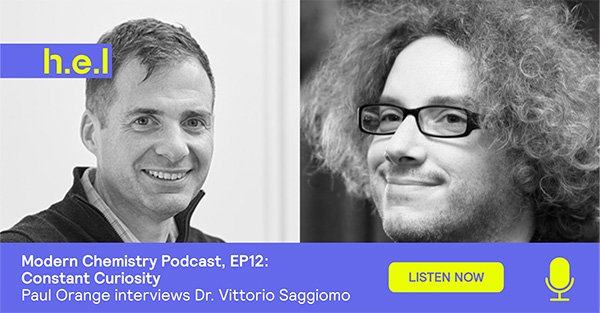Vittorio Saggiomo
Constant curiosity

Episode 12 of the modern Chemistry podcast features Dr. Vittorio Saggiomo, Assistant Professor at Wageningen University, Netherlands. Vittorio describes himself as an “organic chemist turned in new technology and applications. Microfluidics, 3D printing, microcontrollers and automation,
Our theme music is “Wholesome” by Kevin MacLeod
Music from Film Music
License: CC BY
Connect with me (Paul) on LinkedIn.
sensors and devices”. His research uses 3D printing and other novel technologies to develop accessible scientific devices and processes.
Terms used during interview
- PCR – The Polymerase Chain Reaction is a technique for amplifying DNA sequences using a thermostable DNA polymerase enzyme and a cycling reaction temperature profile of heating and cooling. Dedicated instruments typically provide the temperature cycling mechanism.
LAMP reaction – The Loop-mediated isothermal AMPlification reaction is also used to amplify DNA sequences. Unlike PCR, LAMP reactions occur at a single temperature (typically ~60 oC – 65 oC). Therefore, they do not require dedicated instruments to provide thermal cycling but can be conducted in simple water baths or heating blocks. LAMP also uses a DNA polymerase enzyme, although different from PCR. LAMP typically produces higher DNA yields than PCR - CRISPR – CRISPR stands for Clustered Regularly Interspaced Short Palindromic Repeats, a family of specific DNA sequences in prokaryotes. Enzymes, such as ‘Cas9’ can modify DNA at these CRISPR sequences, editing in or out new DNA sequences. Although this technique is known correctly as CRISPR-Cas9, the discovery and development of a range of CRISPR-associated enzymes has led to the term ‘CRISPR’ being used as a generic term for this suite of gene editing technologies.
- PDMS – PolyDiMethylSiloxane is the most widely used silicon-based organic polymer. It is optically clear and usually considered inert, non-toxic, and non-flammable. It is used in a wide range of medical, food, and industrial processes.
As we mentioned during the podcast, Vittorio has several videos and public announcements explaining his research areas. These include:
LAMP SARS-Cov-2 assay in a Nespresso capsule
Microfluidics
- https://www.nanowerk.com/nanotechnology-news/newsid=41556.php
- https://www.youtube.com/watch?v=7z8I7awRYY4
3D printing dichroic nanocomposites (Lycurgus cup)
- https://www.dailymail.co.uk/sciencetech/article-6761173/3D-printed-goblet-changes-colour-deepening-direction-light-hits-it.html
- https://www.nanowerk.com/nanotechnology-news2/newsid=54410.php
- https://www.youtube.com/watch?v=uhetC8Yd44g
- https://www.youtube.com/watch?v=ysxq4akBIVU
Standard 3D printers for microfabrication
- https://onlinelibrary.wiley.com/doi/full/10.1002/admt.202000344
- https://3dprintingindustry.com/news/dutch-researchers-3d-print-velcro-like-mushroom-inspired-fastening-material-183135/
And some Arduino
The full list of Vittorio’s publications can be found here.
Vittorio (and his research) is very present on social media, you can find him on LinkedIn and Twitter.


